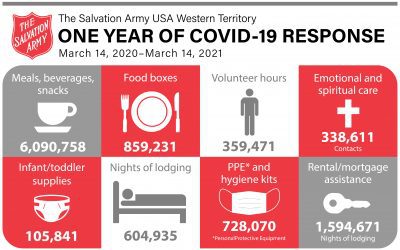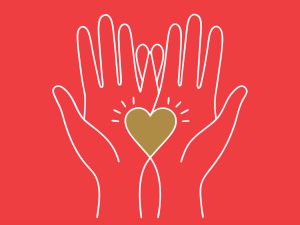Listen and subscribe to the Do Gooders Podcast now. Below is a transcript of the episode, edited for readability. For more information on the people and ideas in the episode, see the links at the bottom of this post.
* * *
It’s been a full year. Can you believe it?
Do you remember that day the World Health Organization declared COVID-19 a pandemic?
Or the day it really set in for you what that would mean for us?
When The Salvation Army began responding to COVID-19 in March 2020, there simply was no way to know the sheer breadth the response would take.
Now, a year later, the need remains great, and the response isn’t over. The Salvation Army is still providing food, rent and mortgage and utility assistance, lodging and emotional and spiritual care, and more. To date, The Salvation Army has provided more than 6 million to those in need in the Western U.S. during the pandemic.
And yet many of the needs The Salvation Army has met over the last year weren’t unique to the pandemic.
Helping those in hunger, poverty and homelessness has been central to The Salvation Army’s ministry since its start in 1865. While pandemic safety measures have meant many of the traditional methods of meeting these needs weren’t possible, The Salvation Army adapted.
As The Salvation Army’s territorial leader in the west, Commissioner Douglas Riley, said: “It’s been a year of change. It’s been a year of constant reflection of what’s happening around us. It’s been a year where we’ve had to be nimble. We have had to make changes. It’s forced us to get outside of our buildings. We’ve had to engage with the communities, our neighborhoods, our friends. We’ve had to do things that we’ve never expected to do.”
You can hear more from him on suffering and joy in episode 68.
In essence, for The Salvation Army, the means may have changed, but the why remained the same: Love God. Love Others.
In this episode of the Do Gooders Podcast, I’m here to share 10 new ways The Salvation Army met old needs over the last year—and then, how you can go about finding your why, too.
1. The Salvation Army held drive-through food pantries.
In the pandemic, of course, gone were the communal meals and shop for yourself food pantries. Instead, drive-through food pantries took center stage throughout the West. And they were buoyed by the support of local partners, including, for example, a gift from the Church of Jesus Christ of Latter-Day Saints last summer that helped provide nearly 25k food boxes to feed a family of four for a week across the West in more than 30 drive-through events.
2. The Salvation Army embraced technology for meal distribution.
In San Francisco, a holiday meals program has been a mainstay for more than 60 years, but COVID-19 meant there were fewer volunteers to help in 2020. And it really didn’t help that the routes to drop off some 5,000 meals were manually laid out.
So, the volunteer manager there worked with HERE 360, a location data company, to use its technology and plot out routes to trim significant time off the deliveries and streamline the holiday meal service.
One volunteer who came out despite COVID-19 and who has been volunteering for thirty years said it was her best experience yet.
3. The Salvation Army took Angel Tree registration online.
A new seasonal assistance software made aspects of the Angel Tree program that were traditionally done in person, virtual. It allowed potential clients to access the online application from home or any mobile device, which helped to put new clothes and toys under the tree for children who would otherwise go without. The software allowed angels to be placed for adoption online, and donors to use the online “Angel Kiosk” to enter the angels they selected.
In the end, The Salvation Army’s effort to rescue Christmas was a success.
And you can hear much more about it in episode 70.
4. The Salvation Army opened shelters in hotels.
In Los Angeles, for example, The Salvation Army’s COVID-19 housing efforts focused on manning a series of hotels with Project Roomkey, a FEMA-approved effort to provide self-isolation via hotel rooms for people experiencing homelessness.
Similar measures were taken at Seattle’s William Booth Center, which was among the first in the state of Washington to utilize CARES Act funding in order to safely shelter some of its most vulnerable veteran residents in a local hotel.

5. The Salvation Army sheltered children to help families.
In Anchorage, Alaska, The Salvation Army set up temporary housing for children whose parents were coping with the virus in response to a request from the city.
6. The Salvation Army hosted drive-in church.
When restrictions limited in-person worship services, the Honoka’a (Hawaii) Corps held drive-in church, texting the congregation to come in their cars to “Hear prayer requests, testimonies and a gospel message to enrich you spiritually.”
In Hemet, California, The Salvation Army got the last-minute green light from the city to host a drive-in Easter service in 2020. Cars full of families parked in the corps parking lot, listening to the radio for the transmitted sermon and music. Following health guidelines, attendees waved to each other, not leaving the cars, and even honked car horns for “amens.”
7. The Salvation Army offered staycation Bible School.
A collaboration between corps in Hollywood, the San Fernando Valley and Phoenix led to a virtual vacation bible school based on the movie “Inside Out.”
It helped bring some sense of normalcy to kids stuck at home, and expanded The Salvation Army’s reach—as corps reported participants tuning in from places including Washington, Florida and Chile. A grandmother in Mexico even saw the video, purchased the supplies and gathered her grandchildren around the table for VBS.
8. The Salvation Army opened hotlines for conversation.
Throughout The Salvation Army, hotlines rose in popularity as a means by which to give support while adhering to social distancing measures. In Denver, The Salvation Army’s call center covering four states, received about 1,100 calls looking for rental, utility, food and emotional and spiritual assistance a day—a number it would usually receive in a month. A national “hope line” call center took calls for months. And one employee launched the Silver Line, a toll-free phone line seniors could call for emotional and spiritual support—and a connection to practical support as well. Hear all about the Silver Line in episode 55.
9. The Salvation Army took work therapy outdoors.
Salvation Army camps throughout the West welcomed beneficiaries of the Adult Rehabilitation Centers (ARCs) for adapted work therapy and recreation. Since the thrift stores that fund the West’s 18 ARCs closed for part of the pandemic, much of the program’s work therapy component was not possible and sober recreational activities were also limited.
So, many ARCs scheduled weekly visits to their nearest Salvation Army camp so beneficiaries could work on low-budget projects like trail maintenance or cleaning and have fun outside, too.
One administrator said, “They love to work out, and they want to help the kids and they know that this is helping the camps so that they can have kids here safely on the trails…I like to bring them out here so they can see what The Salvation Army camp is. So when they go home to their kids, they’ll be like, ‘kids, you have to go.’”
10. The Salvation Army aimed to meet the need for community, even from a distance.
Many seniors who live by themselves stay busy in community, especially at The Salvation Army’s Silvercrest residences for seniors. In Chula Vista, California, the Wellness Director initiated a creative way to keep seniors engaged and active—balcony sessions. The weekly outdoor concerts were held from the parking lot with residents out on their balconies, singing and moving along together, apart. Hear more about it in episode 53.
I could go on and on with the examples we’ve seen in the past year of The Salvation Army meeting old needs in new ways. Of the people within the organization adapting the usual means to remain true to our why: to Love God. Love Others.
So what about when it comes to you? A single do gooder out there in the world.
Every one of us has a unique set of gifts and talents we can use to make our communities better. There is no doubt: You matter and have purpose.
Psalm 57:2 says, “I cry out to God Most High, to God who fulfills his purpose for me.”
God is God. We know he works all things according to his purposes. But our choices and actions also matter.
We can choose to do things that will bring us more joy and give us a deeper sense of purpose. We can choose to leave the full potential of our abilities untapped, content to stay in our comfort zones, or working only to better ourselves.
We can get stuck living by a set of goals that lack passion—goals that aren’t fueled by a genuine why.
Do you know your why—the passion that fuels your purpose?
For nearly 20 years, Google has shared at the end of a year the top questions, moments and individuals that inspired the world to search. Rooted in Google Trends data, Year in Search seeks to capture the essence of a year—in 2020, the world searched “why” more than any other time in history.
Why?
It’s such a simple, little question with such big meaning.
What is the intersection between your passion and purpose? Do you know?
Here’s a few things to consider:
Do you lack joy? Feel unfulfilled or bored? Stuck? That your work is pointless? Or that you’re just aimlessly going through your days?
If so, maybe what you’re looking for is a deeper why. A clearer purpose.
Of course, prayer is always a good place to start—and we have an entire episode on a simple guide to prayer for anyone; check out episode 71 with Pete Greig.
Listening to God through his Word is also key in order to understand, ultimately, what is God is calling us to. Jesus boils it down for us in Matthew 22: to love the Lord your God with all your heart and with all your soul and with all your mind. And to love your neighbor as yourself. And this season we have a two-part series diving deep into what that means.
Next, think about your gifts and strengths. What do people tell you you’re really good at? What comes easy to you? What are you educated or trained in? Or what do you want to learn?
At the same time, consider what you’re passionate about. What gets you excited? What could you talk about with anyone? What would you do if money were no issue?
Is there an intersection between what you’re good at and what you love to do? Where your gifts meet your passions? That could be your purpose.
Ultimately, trust God to lead you where he wants you to go. As Psalm 23:2-3 says, “He leads me beside still waters. He restores my soul. He leads me in the paths of righteousness for his name’s sake.”
I love the quote from Jay Shetty, an author and former monk, who said, “Your passion is for you, and your purpose is for others. When you use your passion in the service of others, it becomes your purpose.”
I’m with Jay that your purpose will only be fueled by passion if it’s used to serve the greater good.
And if you’re not sure where to start, we have a quiz to help you find the cause that best fits your personality so you can discover where you can make the biggest impact today in the Fight For Good.
Our passion and purpose—our why—play critical roles in our lives. It can shape who we are and what we do.
That’s why this season on the Do Gooders Podcast, we’re exploring this idea of why. Of finding your passion and purpose and living in the intersection of them both. We’ll hear from guests about finding resolute hope in anxious times. About a 63-year-old near-lifelong heroin user who found The Salvation Army, Jesus and just graduated with acceptance to a master’s in social work program. About an internal medicine doctor who noticed the lack of genuine rest for so many of her patients and set out to help people find it. About someone self-harming while in ministry and how she found a way out of the darkness and wants to help others to do the same. About a mom who lost her daughter to cancer and now lovingly, knowingly shepherds others through unimaginable grief. About an actual pathway to finding hope and making change to stop inter-generational poverty. About a historian out to end to the subjugation of women as part of some so-called divine order.
Each of our guests has found their why. And each will tell you despite any challenges, aligning your passion and purpose is well worth the effort.
I hope you’ll join us.
Additional resources:
- Did you know The Salvation Army served more than 23 million Americans last year fighting hunger, homelessness, substance abuse and more—all in a Fight for Good? Where can you help? Take our quiz to find your cause and learn how you can join in today.
- Get inside the Caring Magazine Scripture Study Collection and find a suite of free, downloadable Bible studies to guide you through topics from New Beginnings Through Forgiveness, to Understanding our Imago Dei or Life Hacks From David.
Listen and subscribe to the Do Gooders Podcast now.












